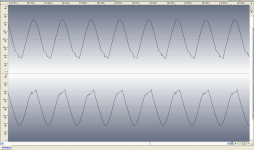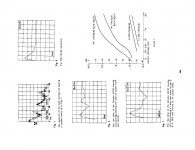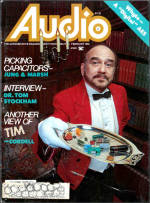For those of you interested in audibility of distortion this is an interesting starting point: QuantAsylum Home Page It gives you an easy ability to dial the distortion up and down and has several different types of distortion to explore. It is an A/B/X type of application so, of course, your ability to hear anything will be extremely suppressed with no peeking allowed.
I, for one, will be interested in the sensitivity to the different types and levels of distortion.
Thank you Demian for the link. It is a nice utility and works very well.
PMA, I'm sure that your measurements of the phono cartridge are OK, but this is a low end typical case, not reasonable worst case. Incidentally, the real problem, besides clicks and pops is cartridge mistracking. It is in no way as slow as what you measured: See my examples measured with analog hi speed test equipment almost 40 years ago. MY rise-time peak is 5us! (figure 7) This closely corresponds to a (TIM 30) test signal, differentiated with an inverse RIAA network or TIM(30,30) (see figure 8). Precise measurements of a phono cartridge with a 13.5KHz passive resonance and the highest tip mass that Ortofon makes is not necessarily the best representative for determinining reasonable worst case design limits.
Thank you John for your input. I have your paper with the images that you have posted now. You are right that my measurement does not cover the worst case, however, I am sure that even the signal with the rise time you had measured is a non-issue for current well designed phono preamps. It may bring more troubles to the power amp (input overload) and especially to speakers, because of the amplitude of clicks and mistracking impulses.
I agree that many modern phono stages are OK. However, I worry about the people here who don't take it very seriously.
Mr Curl
Cartridge mistracking is a situation that has to be corrected at the source.
There is no point in over-designing a preamplifier for the purpose of handling the outcome of mistracking.
For what? For amplifying flawlessly an already highly distorted signal?
If the owner doesn’t recognize the source of the distortion or doesn’t get upset by listening to it, what a high slew rate limit and high overload margin of a good preamplifier will do for him?
Mistracking is due to not enough contact pressure btn diamond faces and both grove flanks.
Wrong azimuth, improper antiskating bias and mostly not enough tracking weight make the diamond lose firm contact with the grove walls when reading high modulation velocity sections.
George
Cartridge mistracking is a situation that has to be corrected at the source.
There is no point in over-designing a preamplifier for the purpose of handling the outcome of mistracking.
For what? For amplifying flawlessly an already highly distorted signal?
If the owner doesn’t recognize the source of the distortion or doesn’t get upset by listening to it, what a high slew rate limit and high overload margin of a good preamplifier will do for him?
Mistracking is due to not enough contact pressure btn diamond faces and both grove flanks.
Wrong azimuth, improper antiskating bias and mostly not enough tracking weight make the diamond lose firm contact with the grove walls when reading high modulation velocity sections.
George
Attachments
Gpagag, cartridge mistracking can happen to virtually every phono cartridge, and some of the best sounding phono cartridges are not immune to cartridge mistracking. Look at the Ortofon MC-20 moving coil cartridge mistracking at 1KHz at the level of 24cm/sec RMS. This IS a high level, but not an impossible level, especially with direct disc recording, that is often the reference standard for vinyl reproduction. For example, figure 5 shows where another quality MC cartridge mis-tracked with a cymbal crash of a direct disc record, as did virtually EVERY MC cartridge that I tested. We have to design for this, IF we want to make a truly quality phono stage, (at any price point).
What I found in my early work from 1978, is that you HAVE to pass TIM (30,30) which is a TIM 30 waveform followed by a passive inverse RIAA that makes the really difficult signal shown in figure 8. Do it or be mid-fi. It is not impossible, but it is easily ignorable by many here, if they don't realize it to be important. .
What I found in my early work from 1978, is that you HAVE to pass TIM (30,30) which is a TIM 30 waveform followed by a passive inverse RIAA that makes the really difficult signal shown in figure 8. Do it or be mid-fi. It is not impossible, but it is easily ignorable by many here, if they don't realize it to be important. .
Gpagag, cartridge mistracking can happen to virtually every phono cartridge, and some of the best sounding phono cartridges are not immune to cartridge mistracking.
We agree. I haven’t objected to this.
With only one remark: Trackability is not an attribute of the cartridge alone.
Trackability depends on the cartridge and the arm as a system.
What cartridge, on which arm and how well installed and adjusted.
Trackability is not a given based on component brand/model or price.
Look at the Ortofon MC-20 moving coil cartridge mistracking at 1KHz at the level of 24cm/sec RMS. This IS a high level, but not an impossible level, especially with direct disc recording, that is often the reference standard for vinyl reproduction. For example, figure 5 shows where another quality MC cartridge mis-tracked with a cymbal crash of a direct disc record, as did virtually EVERY MC cartridge that I tested. We have to design for this, IF we want to make a truly quality phono stage, (at any price point).
Here is my disagreement.
You consider a signal from a mistracking cartridge as a design pass-fail criterion. I find it both wrong and not useful.
Aim for faithfully reproducing a signal from a cartridge which reads that 1kHz @24cm/sec RMS, or whatever but without mistracking.
What I found in my early work from 1978, is that you HAVE to pass TIM (30,30) which is a TIM 30 waveform followed by a passive inverse RIAA that makes the really difficult signal shown in figure 8.
No objection to that 🙂
George
Here is my disagreement.
You consider a signal from a mistracking cartridge as a design pass-fail criterion. I find it both wrong and not useful.
Aim for faithfully reproducing a signal from a cartridge which reads that 1kHz @24cm/sec RMS, or whatever but without mistracking.
Agree, from your picture above it seems your pre-amp didn't behave badly. Just what else should it do?
When a cartridge mistracks... does it produce any HF signal/harmonics etal? amplitudes? Got FFT?
What kind of signal is generated when mistracking occurs?
Hey, the king of thailand just died. And, I'm in thailand. This is going to be something to behold.
-RNM
What kind of signal is generated when mistracking occurs?
Hey, the king of thailand just died. And, I'm in thailand. This is going to be something to behold.
-RNM
Last edited:
Best buy them from flea markets while you can!Quote:
Originally Posted by RNMarsh View Post
Who cares that much for LP's?
Me!
http://www.nytimes.com/2014/08/10/m...ing-up-all-the-worlds-vinyl-records.html?_r=2
When a cartridge mistracks... does it produce any HF signal/harmonics etal? amplitudes? Got FFT?
What kind of signal is generated when mistracking occurs?
Hey, the king of thailand just died. And, I'm in thailand. This is going to be something to behold.
-RNM
I was in Canada when Princess Diana died... maybe not as crazy as you're about to see. 24/7 reporting on Princess Diana, every channel the hotel TV got.
Think of the sell off when he dies.Best buy them from flea markets while you can!
http://www.nytimes.com/2014/08/10/m...ing-up-all-the-worlds-vinyl-records.html?_r=2
Richard, to see the spectrum of a mistracking MC cartridge, just look at fig.5 of the paper I did for the IEEE, so many years ago. Note: it is 20K/div with 10 divisions. Yes, up to 200KHz is typical, I have seen some action at 500KHz with the MC-20 Ortofon cartridge.
Attachments
I went through some Audio Magazine articles related to trackability.
You may be interested
Pages 19-22
http://www.americanradiohistory.com/Archive-Audio/60s/Audio-1966-11.pdf
Pages 19-24
http://www.americanradiohistory.com/Archive-Audio/60s/Audio-1967-03.pdf
Pages 34-36
http://www.americanradiohistory.com/Archive-Audio/70s/Audio-1972-08.pdf
Pages 72-77+
http://www.americanradiohistory.com/Archive-Audio/70s/Audio-1977-07.pdf
Pages 16-22 (also see pages 32-40)
http://www.americanradiohistory.com/Archive-Audio/70s/Audio-1973-08.pdf
Pages 33-45
http://www.americanradiohistory.com/Archive-Audio/70s/Audio-1978-05.pdf
Pages 42-60
http://www.americanradiohistory.com/Archive-Audio/70s/Audio-1978-06.pdf
Pages 38-49 (your beloved TIM)
http://www.americanradiohistory.com/Archive-Audio/80s/Audio-1980-02.pdf
George
You may be interested
Pages 19-22
http://www.americanradiohistory.com/Archive-Audio/60s/Audio-1966-11.pdf
Pages 19-24
http://www.americanradiohistory.com/Archive-Audio/60s/Audio-1967-03.pdf
Pages 34-36
http://www.americanradiohistory.com/Archive-Audio/70s/Audio-1972-08.pdf
Pages 72-77+
http://www.americanradiohistory.com/Archive-Audio/70s/Audio-1977-07.pdf
Pages 16-22 (also see pages 32-40)
http://www.americanradiohistory.com/Archive-Audio/70s/Audio-1973-08.pdf
Pages 33-45
http://www.americanradiohistory.com/Archive-Audio/70s/Audio-1978-05.pdf
Pages 42-60
http://www.americanradiohistory.com/Archive-Audio/70s/Audio-1978-06.pdf
Pages 38-49 (your beloved TIM)
http://www.americanradiohistory.com/Archive-Audio/80s/Audio-1980-02.pdf
George
Isn't that Yung? (our) Richard Marsh is the co-author.
Definitely NOT Jung! ;-)
Richard, to see the spectrum of a mistracking MC cartridge, just look at fig.5 of the paper I did for the IEEE, so many years ago. Note: it is 20K/div with 10 divisions. Yes, up to 200KHz is typical, I have seen some action at 500KHz with the MC-20 Ortofon cartridge.
wow. that is higher than i imagined. what does That say about SR requirements? Its enough to have the mistracking distortion products without adding even more to it by the preamp.
-RNM
wow. that is higher than i imagined. what does That say about SR requirements? Its enough to have the mistracking distortion products without adding even more to it by the preamp.
This is mostly boogeyman stuff, the amplitudes are so low at high f that the slew rates are not important, just look at the time domain plots. Again why on earth would you want to accurately reproduce horribly distorted audio?
Wow! So many years, and the thread is still here! 🙂
Still did not figure out that it is better to limit a frequency band before any active components than to fight for a slew rate above the sky? ;-)
Still did not figure out that it is better to limit a frequency band before any active components than to fight for a slew rate above the sky? ;-)
- Status
- Not open for further replies.
- Home
- Member Areas
- The Lounge
- John Curl's Blowtorch preamplifier part II


